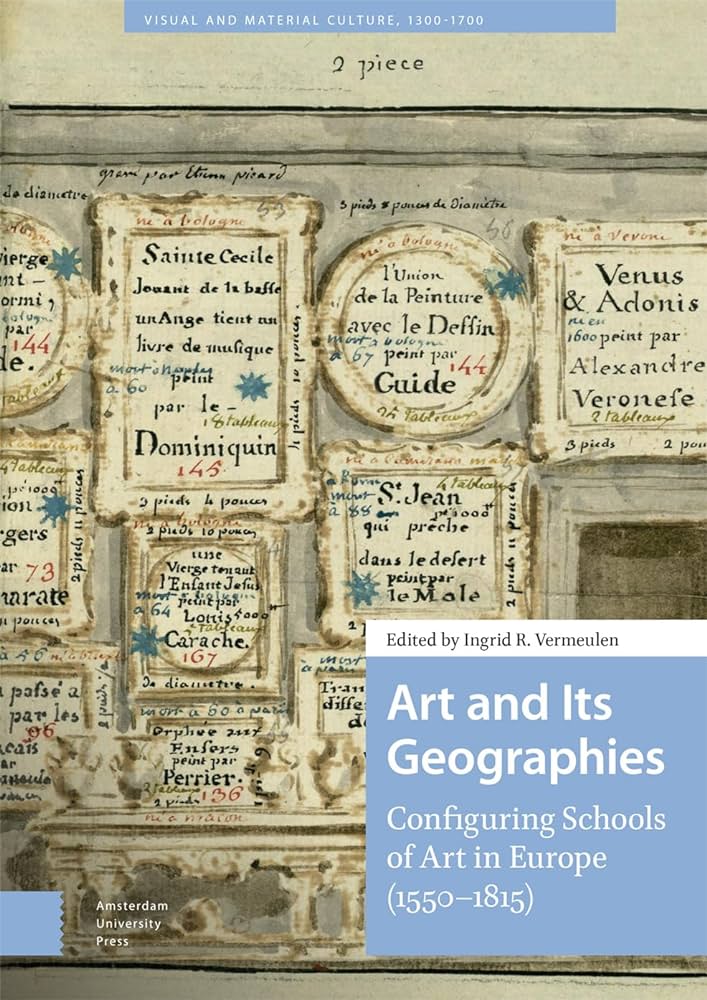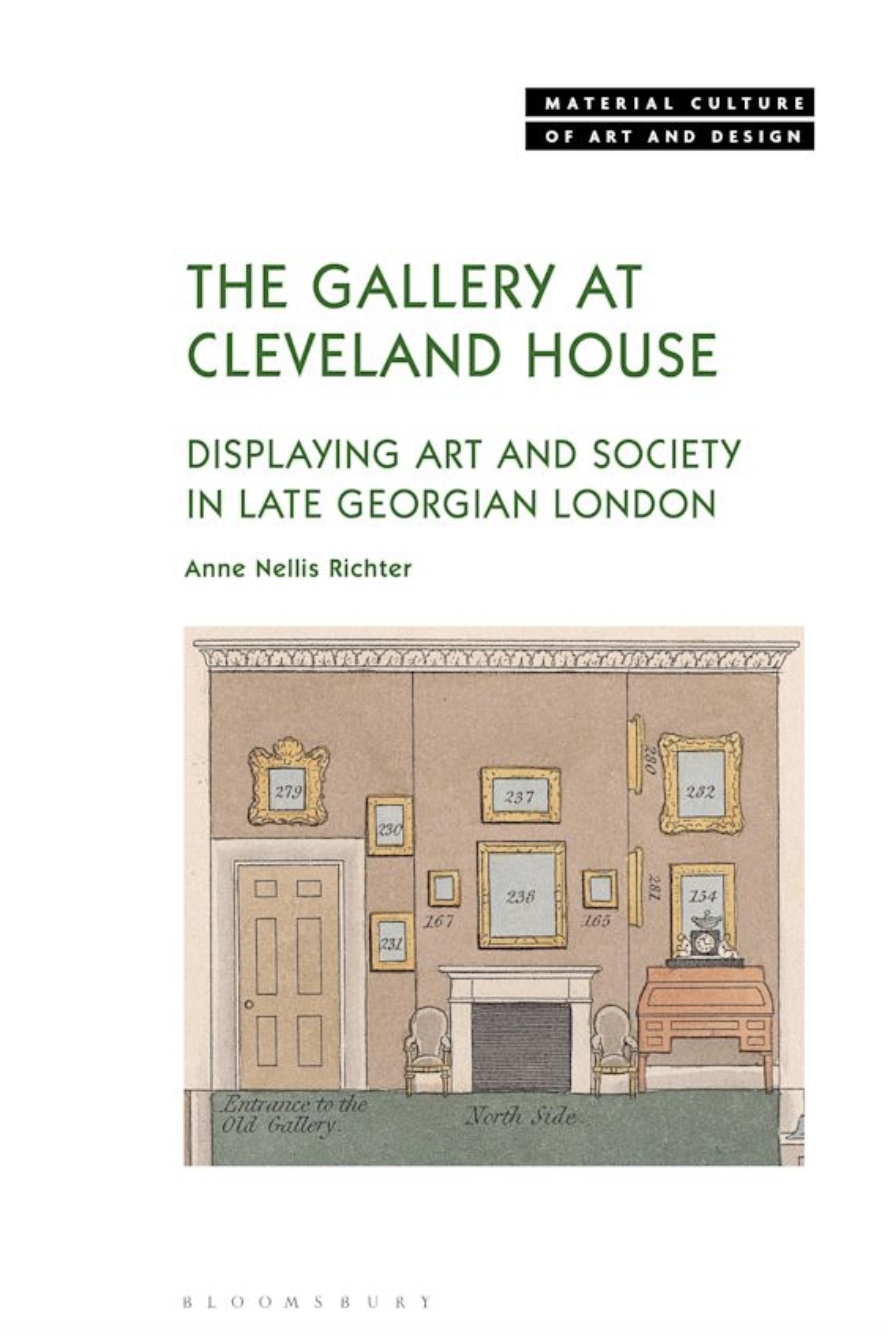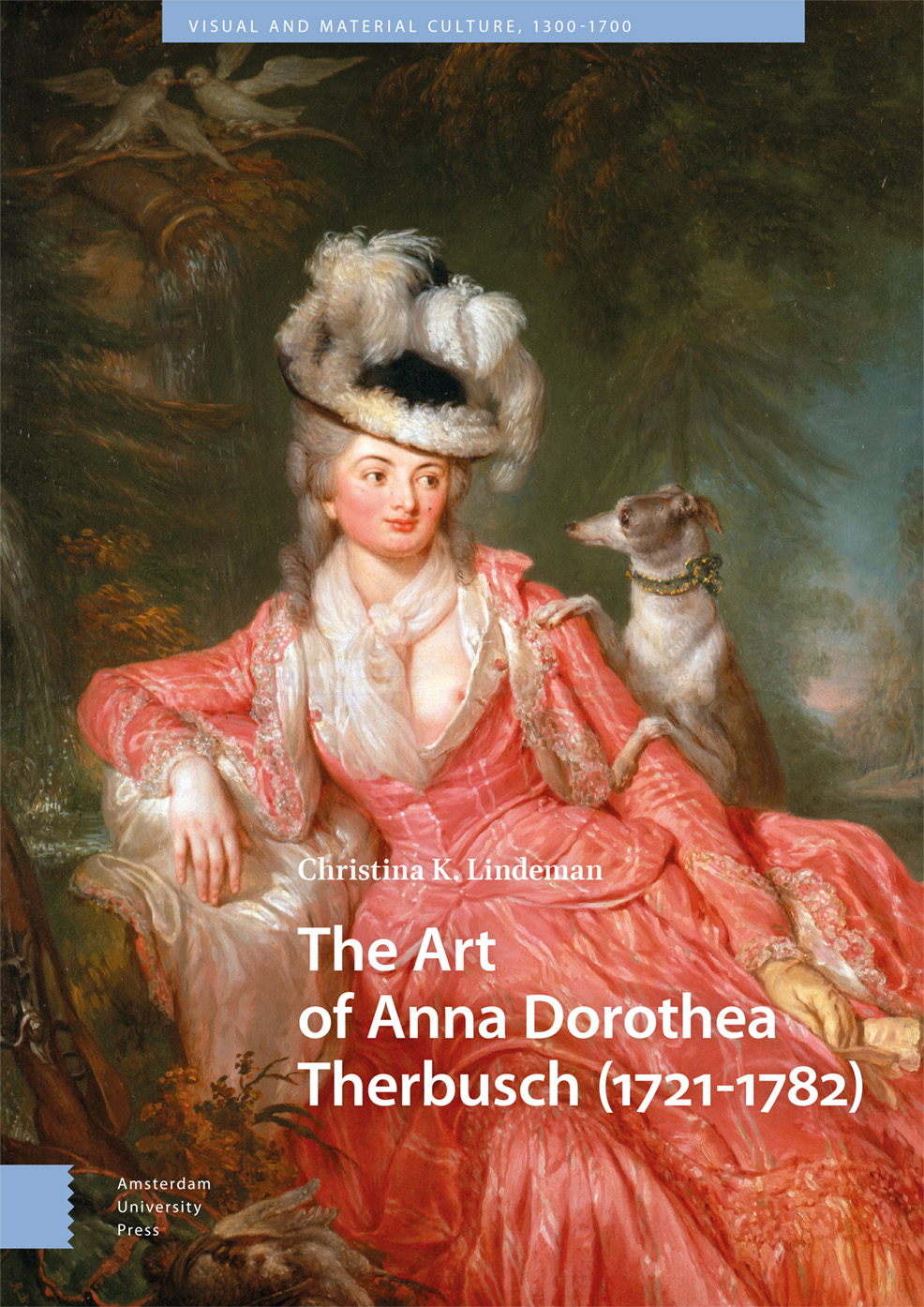New Book | Art and Its Geographies: Configuring Schools of Art
This volume of essays grew out of a June 2019 conference; from Amsterdam UP:
Ingrid Vermeulen, ed., Art and Its Geographies: Configuring Schools of Art in Europe, 1550–1815 (Amsterdam: Amsterdam University Press, 2024), 470 pages, ISBN: 978-9463728140, €159. An ebook as a PDF file is available for free.
 Schools of art represent one of the building blocks of art history. The notion of a school of art emerged in artistic discourse and disseminated across various countries in Europe during the early modern period. Whilst a school of art essentially denotes a group of artists or artworks, it came to be configured in multiple ways, encompassing different meanings of learning, origin, style, or nation, and mediated in various forms via academies, literature, collections, markets, and galleries. Moreover, it contributed to competitive debate around the hierarchy of art and artists in Europe. The ensuing fundamental instability of the notion of a school of art helped to create a pluriform panorama of both distinct and interconnected artistic traditions within the European art world. This edited collection brings together 20 articles devoted to selected case studies from the Italian peninsula, the Low Countries, France, Spain, England, the German Empire, and Russia.
Schools of art represent one of the building blocks of art history. The notion of a school of art emerged in artistic discourse and disseminated across various countries in Europe during the early modern period. Whilst a school of art essentially denotes a group of artists or artworks, it came to be configured in multiple ways, encompassing different meanings of learning, origin, style, or nation, and mediated in various forms via academies, literature, collections, markets, and galleries. Moreover, it contributed to competitive debate around the hierarchy of art and artists in Europe. The ensuing fundamental instability of the notion of a school of art helped to create a pluriform panorama of both distinct and interconnected artistic traditions within the European art world. This edited collection brings together 20 articles devoted to selected case studies from the Italian peninsula, the Low Countries, France, Spain, England, the German Empire, and Russia.
Ingrid R. Vermeulen is Associate Professor of Early-Modern Art History at Vrije Universiteit Amsterdam. Her research focuses on the early-modern history of art history grounded in art literature, collections, and museums. It generated the book Picturing Art History (2010) and the project The Artistic Taste of Nations (2015) funded by the Dutch Research Council (NWO).
c o n t e n t s
Introduction
• Art and Its Geographies, 1550–1815: Configuring Schools of Art in Europe — Ingrid Vermeulen
Academies of Art, Churches, and Collective Artistic Identities
• Notions of Nationhood and Artistic Identity in Sixteenth- and Seventeenth-Century Rome — Susanne Kubersky-Piredda
• A Failed Attempt to Establish a Spanish Art Academy in Rome (1680): A New Reading of Archival Documents — Maria Onori
• Mantua: A School of History and Heritage (1752–1797) — Ludovica Cappelletti
Art Literature, Artists, and Transnational Identities
• Conceptualizing Schools of Art. Giovanni Battista Agucchi’s (1570–1632) Theory and Its Afterlife — Elisabeth Oy-Marra
• Claimed by All or Too Elusive to Include: The Appreciation of Mobile Artists by Netherlandish Artists’ Biographers — Marije Osnabrugge
• The Galeriewerk and the Self-Fashioning of Artists at the Dresden Court — Ewa Manikowska
Drawings, Connoisseurship, and Geography
• Padre Sebastiano Resta (1635–1714) and the Italian Schools of Design — Simonetta Prosperi Valenti Rodinò
• Connoisseurship Beyond Geography: Some Puzzling Genoese Drawings from Filippo Baldinucci’s (1624–1696) Personal Collection — Federica Mancini
• Arthur Pond’s (1705–1758) Prints in Imitations of Drawings (1734–1736): Old Masters, Copies, and the National School in Early Eighteenth-Century Britain — Sarah W. Mallory
Taste and Genius of Nations
• ‘Taste of Nations’: Roger de Piles’ (1635–1709) Diplomatic Take on the European Schools of Art — Ingrid Vermeulen
• How Do Great Geniuses Appear in a Nation? A Political Problem for the Enlightenment Period — Pascal Griener
Prints, Collecting, and Classification
• Dezallier d’Argenville’s (1680–1765) Concept of a Print Collection: by Topic or by School? – Gaëtane Maës
• Michael Huber’s (1727–1804) Notices (1787) and Manuel (1797–1808): A Comparative Analysis of the French School of the Eighteenth Century — Véronique Meyer
• Chronology and School: Questioning Two Competing Criteria for the Classification of Print Collections around 1800 — Stephan Brakensiek
Art Markets: Selling and Collecting
• The Eighteenth-Century Art Market and the Northern- and Southern-Netherlandish Schools of Painting: Together or Apart? — Everhard Korthals Altes
• The Print Collector Pieter Cornelis van Leyden (1717–1788): Literature of Art, Concepts of School, and the Genesis of a Connoisseur — Huigen Leeflang
• The Problem of European Painting Schools in the Context of the Russian Enlightenment: Alexander Stroganoff (1733–1811) and his Catalogue (1793, 1800, 1807) — Irina Emelianova
On Public Display in Picture Galleries
• Everyman’s Aesthetic Considerations on a Visible History of Art: Joseph Sebastian von Rittershausen’s (1748–1820) Betrachtungen (1785) on Christian von Mechel’s (1737–1817) Work at the Imperial Picture Gallery in Vienna — Cecilia Hurley
• An Organisation by Schools Considered Too Commercial for the Newly Founded Louvre Museum — Christine Godfroy-Gallardo
• Scuole Italiane or Scuola Italiana? Art Display, Historiography, and Cultural Nationalism in the Pinacoteca Vaticana after 1815 — Pier Paolo Racioppi
Contributors
Illustration Credits
Index
Call for Papers | Drawn to Blue
From ArtHist.net:
Drawn to Blue
Online, 12–13 November 2024
Organized by the J. Paul Getty Museum and the University of Amsterdam
Proposals due by 31 July 2024
Made from discarded blue rags, early modern blue paper was a humble material. Despite that, its manufacture required expert knowledge and its impact on European draftsmanship was transformative. This call seeks proposals for 20-minute papers that address the history of European blue paper from the fourteenth century until 1800. Open to art historians, curators, conservators, conservation scientists, paper historians, papermakers, and dyers, successful proposals will demonstrate original archival research and/or object-based approach to their discussion of works on blue paper. While all topics will be considered, organizers encourage papers related to the following subjects:
• blue paper production outside the Italian peninsula and the Netherlands
• color shift in blue paper and its implications
• technical and/or scientific examination of blue paper
• artistic applications of blue paper
• non-artistic uses of blue paper
• blue paper as means of transcultural exchange
• intersection between blue paper production and textile trade and technological developments
Co-organized by the J. Paul Getty Museum and the University of Amsterdam, this interdisciplinary online symposium will take place 12–13 November 2024, over two morning sessions Pacific Standard Time. Proposals should include author’s name, title, and an abstract (not to exceed 500 words). Submissions should be sent to drawings@getty.edu by 31 July 2024. Please put ‘Drawn to Blue’ in the subject. Accepted speakers will be notified by mid-August.
◊ ◊ ◊ ◊ ◊
Earlier this year, The Getty presented the exhibition Drawing on Blue (30 January — 28 April 2024) and published an accompanying book edited by the show’s curators, Edina Adam and Michelle Sullivan, Drawing on Blue: European Drawings on Blue Paper, 1400s–1700s (Los Angeles: J. Paul Getty Museum, 2024).
Conference | New Perspectives on Life Drawing
From The Courtauld (and note the two virtual sessions, June 17 and June 18):
Pose, Power, Practice: New Perspectives on Life Drawing
The Courtauld Institute of Art, Vernon Square, London, 20 June 2024
Organised by Zoë Dostal and Isabel Bird
From the 16th century to the present, drawing the human body from life has remained a mainstay of Western institutional art practice. Despite significant shifts in the aesthetics, media, and purpose of art over the last five hundred years, life drawing endures in both the studio and the classroom.
Pose, Power, Practice is a one-day symposium that seeks to reassess the state of the field on life drawing and apply new critical frameworks to this sustained practice. It aims to better understand life drawing in all its complexity, from its presumed advantages to its consequences. This is a practice deeply intertwined with concerns central to the discipline of art history, including but not limited to: the power dynamics of the gaze; the politics of representation; recognition of multiple forms of artistic labour; formulations of race, dis/ability, gender, and sexuality; and critiques of institutions. How has life drawing changed across time and place? How and why has it endured as a pedagogical practice, despite repeated dismissals of its “academicism”? What uses does it hold today, for artists and art historians alike?
Our re-evaluation of life drawing will start with two virtual panels earlier in the week, hosted in collaboration with The Drawing Foundation. At Life Drawing After Death on Monday, 17 June, 16:00 BST and Life Model as Laborer and Artist on Tuesday, 18 June, 13:00 BST, we will dive into topics that will resonate with and inform our in-person discussions on the varied perspectives, ethical considerations, and diverse practices that make up life drawing. Visit The Drawing Foundation’s event webpage for further details.
Organised by Dr Zoë Dostal (Kress Fellow, The Courtauld) and Isabel Bird (PhD candidate, Harvard University)
p r o g r a m m e
10.00 Registration, with coffee and tea
10.30 Welcome
• Professor Alixe Bovey (The Courtauld)
• Zoë Dostal (The Courtauld) and Isabel Bird (Harvard University)
10.50 Session 1 | Life Drawing as an Enduring Practice
Chaired by Tara Versey (Royal Drawing School)
• Antje Southern (The King’s Foundation Diploma Year), The Creative Impact of Life Drawing at Fine Art Foundation Level: A Case Study
• Susanne Müller-Bechtel (Saxon Academy of Sciences and Humanities in Leipzig – Young Forum), The Experimental Arrangement in the ‘Aktsaal’ at the Early Modern Academies and the Effects on the Artistic Practice
• John Fagg (University of Birmingham), ‘Take the pose of the model, yourself’: Empathy in Robert Henri’s Pedagogy and Practice
12.15 Lunch Break
13.45 Session 2 | Exposure and Expression: Life Modelling
Chaired by Carole Nataf (The Courtauld)
• Fra Beecher (Director of United Models Life Drawing CIC), The Body, Captured: Photography and the Life Room
• Tomáš Valeš (Institute of Art History, Czech Academy of Sciences, Prague / Department of Art History, Masaryk University, Brno), Employed, Exposed, Captured: Life Model Praxis in 18th-Century Vienna
• Yanyun Chen (School of the Museum of Fine Arts, Tufts University), Skinning Nudity: Life Modelling Practice in Singapore
15.10 Coffee and tea
15.40 Session 3 | Beyond the Life Room: Unexpected Practices
Chaired by Professor Joanna Woodall (The Courtauld)
• Suri Li (University of Cambridge), A Renaissance Nun’s Drawing Practices: Suor Plautilla Nelli (1524–1588) and Her Drawing of a Young Woman
• Oriane Poret (Université Lyon 2, LARHRA), Beyond Human: Drawing from Non-Human Life during the 19th Century
• Nick Robbins (University College London), The Life Academy and the Origins of Landscape
17.00 Drinks Reception



















leave a comment